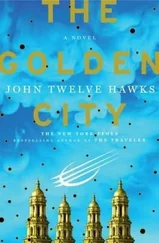“What happened?” he asked. “I saw sand coming out of the tunnel. Are you injured? Are you all right?”
Maya ripped off the face mask, spit out the mouthpiece, and gasped for breath. Her lungs were burning, and it felt as if someone had punched her in the stomach. Lumbroso kept talking to her, but she couldn’t answer. She was incapable of speech, and only one thought stayed in her brain: I’m still alive .
The underwater camera dangled from its lanyard, and she handed it to him like a precious stone.
AROUND EIGHT O’CLOCK the next morning, Maya was a customer at an outdoor café in the Piazza San Lorenzo in Lucina. The piazza was less than one hundred yards from the entrance to the deserted building that concealed the sundial. Directly below her feet were layers of the past and secret rivers flowing through the darkness.
If she closed her eyes, she could see herself trapped within the underwater tunnel, but she had no desire to reflect on that moment. She was alive and in this world. Everything that surrounded her seemed both ordinary-and beautiful. She touched the smooth marble top of the table while a young Italian waiter brought her a cup of cappuccino and a peach tart decorated with a sprig of mint. The crust of the tart was light and flaky, and she let the sweet peach filling linger on her tongue. Although her sword case hung from the back of the wrought-iron chair, she had the mad impulse to abandon it and wander around the square like an ordinary woman, entering each shop to sniff the perfume samples and try on silk scarves.
Lumbroso arrived as she finished the pastry. He was wearing his usual dark clothing and carrying a leather portfolio beneath his arm. “ Buon giorno , Maya. Come sta? It is a pleasure to see you this morning.” He sat and ordered a cappuccino.
“Last week I saw a tourist ordering a cappuccino at five o’clock in the afternoon. This is Roma, not Starbucks! The waiter was deeply offended. There should be a sign in all trattorias: ‘It’s Against the Law to Order a Cappuccino after Ten in the Morning.’”
Maya smiled. “What about an espresso?”
“Espresso is appropriate.” He opened the portfolio and pulled out a manila folder filled with glossy photographs. “I downloaded the images last night and printed them on photo paper. You did a very good job, Maya. I could read everything quite clearly.”
“Did it mention an access point?”
“The sundial combined locations that our modern sensibility would consider ‘real,’ as well as those places that connected you to another world. Look at this image…” He placed a photograph in front of her. “It’s written in Latin and refers to Aegyptus -the Roman name for Egypt. After the death of Cleopatra, Egypt became part of the Empire. To the right of this Latin inscription are words in Greek.”
Lumbroso handed her another photograph and sipped his cappuccino. Maya studied a photograph that showed both Greek and Latin words.
“The inscription uses a word that means ‘doorway’ or ‘portal.’” Lumbroso picked up the photograph and began to translate. “The portal to God was taken from Ludaea to Ta Netjer -the Land of God.”
“In other words, we don’t know where the doorway is.”
“I disagree. The directions are as clear as one of those guidebooks the tourists carry around Rome. Ludaea is the Roman name for the province that included Jerusalem. Ta Netjer -the Land of God-was also called Punt . It’s generally believed to be northern Ethiopia.”
Maya shrugged. “I don’t understand, Simon. How could a portal-an access point-be portable?”
“Only one famous object was taken from Jerusalem to Ethiopia. It’s a ‘portal’ that, in our modern day, is referred to as the Ark of the Covenant.”
“The Ark is just a legend,” Maya said. “It’s like Atlantis or King Arthur.”
Lumbroso leaned forward and spoke in a low voice. “I haven’t studied the books about King Arthur, but I do know a great deal about the Ark of the Covenant. It’s a chest of acacia wood plated with gold, with a solid-gold cover called a kapporet . The Bible even gives us the dimensions of this sacred object. It’s about forty-five inches in length and twenty-seven inches in width.
“The Ark was created by the Israelites during the exile in the desert. It had a place of honor in the first temple, built by Solomon. The common assumption was that the Ark contained the Ten Commandments, but I think it’s more logical that it’s some kind of access point. The Ark was kept in the ‘Holy of Holies’-the innermost part of the temple.”
“But wasn’t it destroyed by the Assyrians?”
“You probably mean the Babylonians.” Lumbroso smiled. “The one fact that is consistent in all sources is that the Ark wasn’t in the temple when Nebuchadnezzar sacked Jerusalem. The Babylonians made detailed lists of their plunder, but the Ark was never mentioned. The famous Copper Scroll-one of the Dead Sea Scrolls found in 1947-states explicitly that the Mishkan , the portable temple for the Ark, was removed from the temple before the invasion.
“A few people think that Josiah hid the Ark somewhere in Israel, but the inscription on the sundial reflects the legend that it was taken to Ethiopia by Menelik the First, the son of Solomon and the Queen of Sheba. The Romans knew that when they wrote the inscription.”
“So the Ark is in Africa?”
“It’s not exactly a secret, Maya. You can go on the Internet or read a dozen different books. The Ark is currently being kept at the Church of Saint Mary of Zion in the northern Ethiopian city of Axum. It’s guarded by a group of Ethiopian priests, and only one priest is allowed to go into the shrine.”
“There’s one problem with your theory,” Maya said. “If the Ark is in Ethiopia, then why hasn’t Israel done something about reclaiming it or protecting it?”
“Ahhh, but they have. In 1972, a group of archaeologists from the Israel Museum flew to Ethiopia. They received permission from the Emperor Haile Selassie to examine certain historical artifacts. At the time there was a major drought in the province of Wollo and the emperor was desperate for international aid.
“These archaeologists traveled to the monasteries on Lake Tana and to the city of Axum. But, strangely enough, they never issued a report or any other public statement. Two weeks after their return to Jerusalem, Israel began to send military and humanitarian aid to Ethiopia. This support continued after the emperor’s death in 1975. It still continues today.” Lumbroso smiled and finished his cappuccino. “The Israelis don’t publicize this aid and neither do the Ethiopians. Because, of course, there’s no political reason for giving the money-unless you believe in the Ark.”
Maya shook her head. “Maybe a few historians have thought up this theory and a few Ethiopian priests want to believe it. But why didn’t the Israelis just grab the Ark and take it back to Jerusalem?”
“Because the Ark goes in a temple which no longer exists. The Dome of the Rock currently occupies the site: that’s where the Prophet Muhammad ascended into paradise. If the Ark were returned to Jerusalem, then certain fundamentalist groups-both Christian and Jewish-would want to destroy the Dome of the Rock and rebuild the temple. That would start a war that would dwarf any previous conflicts.
“The men and women who lead Israel are devout Jews, but they’re also pragmatists. Their objective is the continual survival of the Jewish people-not the start of World War Three. It’s best for everyone if the Ark stays in Ethiopia and that people are encouraged to believe that it was destroyed thousands of years ago.”
Читать дальше












